Translate4Rail to remove language barriers on European corridors

The International Union of Railways (UIC) and RailNetEurope (RNE) have joined forces for removing language barriers on rail freight corridors across Europe. Within the Translate4Rail project, both organisations are developing a special language tool for free and reliable communication between train drivers. Shift2Rail Joint Undertaking has allocated over 248,000 euros for funding the project.
As of today, train drivers that operate locomotives on the cross-border connections are required to obtain a level B1 language certificate. The UIC considers this as “one of the many examples of a lack of a level playing field between different modes”, as the requirement leads to a lack of competent drivers.
To overcome this barrier, the UIC and RNE launched on 1 December 2019 a joint project named Translate4Rail. It is coordinated by the UIC Freight Department and will last for 24 months, until 30 November 2021. According to the European Commission, the main target of the Translate4Rail project is ” to at least maintain the level of safety, increase the traffic fluidity at borders and to increase the competitiveness of the rail sector.”
Several stages
In order to achieve this, the joint project of the UIC and RNE needs to leapfrog several stages. First, the specifications of the planned tool for communication between a train driver and an infrastructure manager traffic controller should be defined. “This definition must set the functional characteristics of the information tool and of the software of the voice recognition and the transfer of the voice messages to be sent to the traffic controller,” the Shift2Rail JU noted.
Text continues below the picture

Then, the standard wordings for communication must be defined. Among them are the words and phrases that transmit usual information on the progress of the train (position, stoppings, authorisation of restarting, etc.) and the status of the tracks, as well as exceptional information on any events occurring on his/her own train, a pass-by train, infrastructure (level crossing, signalling, etc.) in case of unusual functioning. Moreover, these wordings must include emergency information in case of incidents or accidents. All this information should be harmonised to allow a sound translation and transmission to the recipient.
Afterwards, the UIC and RNE will start procurement for a tool fulfilling the above-mentioned specifications. The two next stages envisage the tests of the tool across Europe with the participation of the railway undertakings and infrastructure managers and the development of the necessary documentation for the pilot operations. Subsequently, train drivers should take a special training programme for using this tool. Finally, the results of the project must be published and implemented on the European railway network.
Read also:
You just read one of our premium articles free of charge
Want full access? Take advantage of our exclusive offer





Why don’t they just learn English? That’s what they did in the air and maritime sectors. Plus it has side benefits for those who learn it.
English language for European railways is a long-pending and controversial issue. Too many discussions have been carried out but without any result. And another factor is Brexit. As Mr Juncker said five years ago to the journalists, everybody should learn German (something like that)
no one speaks english now in european Union… so why let them speak a language, which is no more in? Germans can learn usefull languages like Polish and French French may speak German and spanish. this is quite easy and the use of english is only an opression to learn something which is not necessary
There is a lack of train drivers in Europe who can speak several languages. That’s why this tool will be useful